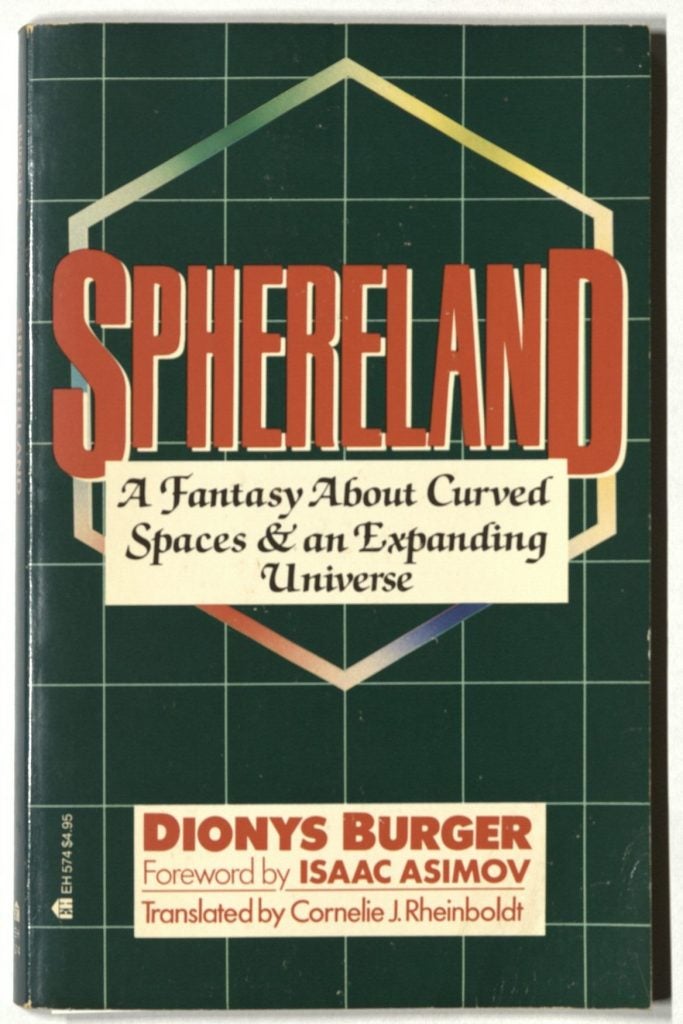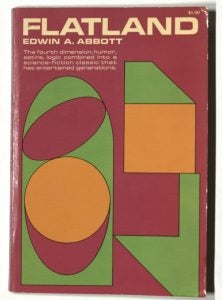Schlobin Selections #8: Sphereland: A Fantasy About Curved Spaces and an Expanding Universe ( Bolland: een roman van gekromde ruimten en uitdijend heelal) by Dionys Burger, Translated by Cornelie J. Rheinboldt
Over the next several weeks, we will be highlighting a select number of titles and authors from the James H. and Virginia Schlobin Literature of the Fantastic Collection. Established in 2004 by East Carolina University English Professor Roger C. Schlobin, the James H. and Virginia Schlobin Literature of the Fantastic Collection provides scholarly materials to researchers and students interested in Science Fiction and Fantasy literature. The collection consists of over 3,700 individual books, mostly primary literature in the form of novels, and collected short narratives with some additional secondary literature and scholarly criticism related to the various genres that are represented. The James H. and Virginia Schlobin Literature of the Fantastic Collection also has a related manuscripts collection which consists of nearly 5 cubic feet of materials which can be accessed online.

Sphereland: A Fantasy About Curved Spaces and an Expanding Universe by Dionys Burger, translated by Cornelie J. Rheinboldt. This copy also includes a printing of Edwin A. Abbott’s Flatland.
Title: Sphereland: A Fantasy About Curved Spaces and an Expanding Universe ( Bolland: een roman van gekromde ruimten en uitdijend heelal)
Author: Dionys Burger
Translated by: Cornelie J. Rheinboldt
Publisher: Barnes & Noble books
Publication Date: 1983
Page Count: 208
Call Number: QA699 .B813 1983
Originally published by Dutch author Dionys Burger (1892-1987) in 1957, Sphereland: A Fantasy About Curved Spaces and an Expanding Universe (translated from the original title Bolland: een roman van gekromde ruimten en uitdijend heelal) was first translated to English by Cornelie J. Rheinboldt and republished in 1965. Intended to be a sequel to Edwin Abbott Abbott’s 1884 work Flatland: A Romance of Many Dimensions, Sphereland builds upon the social and mathematical work that Flatland was initially based upon. In Sphereland, the circles that reside in the fictional world speak out against A Square’s (A Square is the pen name that Abbott wrote his 1884 work and it is also the main character of the Flatland title) findings related to the third dimension. Due to the Circles status in society, A Square is criticized by his fellow citizens of Flatland and comes to be considered an outcast of society. Similarly, when a prominent member of Flatland identifies a Triangle that is greater than 180 degrees, he is also criticized, eventually losing his job since his findings go against the findings of Euclidean geometry, which is viewed by the citizens of Flatland as a sort of religion.
Eventually, the discoverer of the Triangle begins to work with A Hexagon, the grandson of A Square, and together they develop a theory that argues that they and the rest of Flatland actually live on a large sphere, explaining the unusual measurements found by A Square and the two of them. Despite being able to prove their theory correct, the scientific community of Flatland refuses to accept this new concept. It does not allow the rest of the citizens of Flatland to be enlightened about this new finding. Despite this censorship by the scientific community, the Flatland society continues to progress, eventually developing space travel. Using their newfound knowledge, the two characters are able to discover that the universe that Flatland exists within is expanding. Armed with the new information, A Hexagon does as his grandfather had done previously and writes a book that contains all of their new findings and discoveries. Once done, A Hexagon decides that this book will not be opened until the citizens of Flatland widely accept the discovery of the expanding universe.

Flatland by Edwin A. Abbott
White Sphereland did not receive much attention from critics of the science fiction genre upon its initial release or the release of the transcribed version; scholars, particularly those in the field of mathematics, have criticized Burger’s work much more harshly in recent years. Some of these critiques include saying the story lacks any real substance and that its use of scientific understanding has been described by some as “rudimentary at best.” Others have labeled it as boring and repetitive at times in a way that will ultimately confuse the readers while offering no new insights into the mathematical studies, instead simply repeating information that is already widely known. Despite this criticism, Burger’s Sphereland was the inspiration for the 2012 animated film Flatland 2: Sphereland, a sequel to the 2007 film Flatland: The Movie.
Read previous entries from Schlobin Selections.
Sources:
- Kasman, Alex. “Sphereland: A Fantasy About Curved Spaces and an Expanding Universe .” Mathematical Fiction, n.d. https://kasmana.people.cofc.edu/MATHFICT/mfview.php?callnumber=mf11.
- “Sphereland: A Fantasy about Curved Spaces and an Expanding Universe by Dionys Burger.” LibraryThing.com, n.d. https://www.librarything.com/work/322693.
